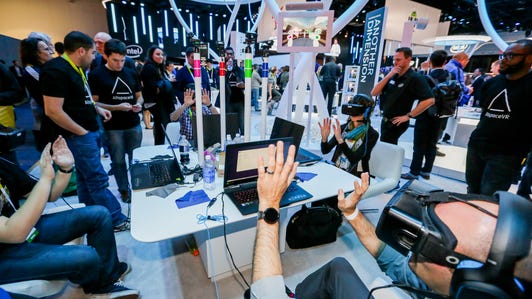
Sarah Tew/CNET
The personal computer isn’t back — not yet anyway — but it’s not dead either.
The changed fortunes of the once downtrodden PC could be seen front and center in Intel’s latest earnings report, issued Thursday. The company wrapped up a solid 2014 by announcing its first full year of revenue growth since 2011 and another quarter of better-than-expected profit, driven in part by rebounding PC revenue.
The results sync up with research firm Gartner’s assessment that the desktop and laptop market is now experiencing “slow but consistent improvement,” following more than two years of declining sales as users flocked to smartphones and tablets. The change can be attributed to a handful of factors, including Microsoft stopping technical support of its Windows XP operating system last year, forcing users to upgrade to newer devices, as well as the rise of hybrid tablet-laptop computers, dubbed “2-in-1” devices.
Intel, whose chips power most PCs, is a big beneficiary of this change. In 2012 and 2013, the Santa Clara., Calif.-based company posted lower overall sales. However, as more businesses and consumers have been upgrading their computers, Intel in 2014 snapped that downward slide, saying revenue rose 6 percent, to $55.9 billion.
“I’m feeling pretty good about where we are in the PC market,” CEO Brian Krzanich said during a call with analysts Thursday, referring to devices coming out with new technologies and slimmer designs.
Intel’s fourth-quarter revenue was also up 6 percent, to $14.7 billion, and net income rose 39 percent, to $3.7 billion, from a year earlier. Its per-share earnings of 74 cents handily topped Wall Street’s expectations by 8 cents a share.
The chipmaker isn’t out of the woods yet. Its shares were down about 1 percent in after-hours trading because it forecast slightly lighter-than-expected revenues in 2015, suggesting uncertainty over whether consumers will keep buying new PCs.
Still, plenty of other companies are gaining from the latest PC trend, from Apple posting blockbuster Mac sales to Lenovo managing double-digit shipment growth last year, according to Gartner and IDC. Intel, whose future is tied to the PC perhaps more than any other firm, hopes to continue this march upward with the release this month of its long-awaited fifth-generation Core i-series processors and its RealSense 3D camera technology being integrated into more computers. Microsoft’s release of Windows 10 later this year could also help boost sales.
Intel booth tour at CES 2015 (pictures)






As the laptop and desktop market shows signs of revival, many PC makers used the Consumer Electronics Show this month to show off laptops that are lighter and more powerful, with longer battery life, including the 1.7-pound Lenovo LaVie and the Dell XPS 13, with an aesthetically pleasing thin display frame.
Intel said Thursday that its fourth-quarter PC sales rose 3 percent from a year earlier to $8.9 billion, as it sold more PC chips but at slightly lower prices, and data center revenue rose 25 percent, to $4.1 billion, helped by the rising demand of Intel chips in cloud-computing servers.
But while Intel’s PC and data center business enjoyed a strong 2014 — helping drive the company’s stock up about 40 percent last year — the chipmaker has been losing billions of dollars trying to build up a mobile-chips business. In November, Intel said it would combine the struggling mobile chips group with the PC division to try bolstering mobile sales.
The mobile division’s numbers were just as bleak in the latest quarter, with revenue going negative — a rarity for any income statement — because of Intel paying subsidies to customers to take its mobile chips. Revenue was negative $6 million on a $1.1 billion loss. Total losses for the year were $4.2 billion. The company has said it will significantly reduce its mobile losses in 2015.
RELATED STORIES
- Lighter laptops, longer-lasting batteries for computers at CES 2015
- Intel tech brings us closer to the world of ‘Minority Report’
- Intel’s diversity goals face many challenges
- Intel tops Q3 expectations despite a $1B loss in mobile biz
Separately, CEO Krzanich last week made waves in the tech world at CES by unveiling Intel’s new $300 million diversity initiative, with the company looking to boost the number of women and underrepresented minorities in the industry.
Krzanich this week attended a conference hosted by the civil rights nonprofit Rainbow/PUSH Coalition, where he told the crowd the initiative would include reviewing the diversity statistics of Intel and its suppliers, as well as increasing the diversity of Intel’s board in the future. Portions of the $300 million, Krzanich said, would go to scholarships and K-12 programs, and to boosting diverse hiring practices and funding startups led by minority entrepreneurs.
Jesse Jackson, who founded Rainbow/PUSH and interviewed Krzanich at the event, called the effort “a breakthrough in leadership.”




